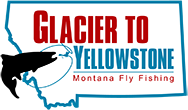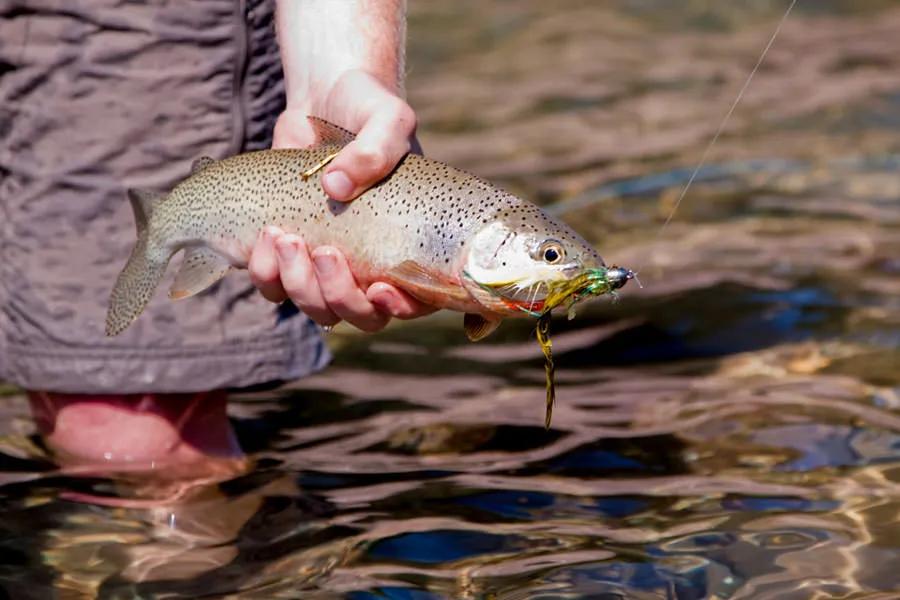Spotted Bear River is a tributary of the South Fork of the Flathead River above Hungry Horse Reservoir
The Spotted Bear Campground, ranger station and river all come together 55 miles from the dam. Spotted Bear River is indeed a river during spring run-off, but by summer it drops to creek size. The river is excellent for 10-to 14-inch cutthroats, but once again access is difficult in all but a few places. From the confluence with the South Fork to Beaver Creek Campground is 9.4 miles, with only the lower stretch accessible for parking your vehicle and walking down to the river. Two miles above the Beaver Creek Campground (non-fee) the road is blocked. The access roads in the upper half are not really access roads! The first three access roads in the lower half of the road will get you right to the river or very close; in between you have to park and hike down the mountain. The hike back up the mountain would be tough for me, but the biggest challenge for me would be on deciding the question, "Do I walk up the road looking for my rig or walk down?"
When I took the first access road that led to a primitive camping site on the river, I ran into what I consider a real "Old Timer". I had just stopped to fish a section of the river and caught three fat cutthroats from 10 to 12 inches. I worked one riffle and one hole, but in truth I had to fish these two spots hard and smart to bring them up from the bottom. I was a bit disappointed, but it was almost 90 degrees, so even the usual greedy little ones were sulking from the heat. As I pulled out, I drove past a primitive campsite and spotted an older man sitting in a lawn chair reading a novel.
I leaned out of my truck window and asked him about the typical size for this section. Pat Harbin smiled. Wearing a white brimmed hat and red suspenders, Pat looked like the friendly grandfather type. His kind eyes and easy smile marked him as a soft touch for grandkids.
"Depends when you're here," he said.
"Well, I just caught three over there and the largest was 12 inches. What kind of size do you generally catch?"
"Depends on when I was here. The first time was 1928. That was 70 years ago."
Without even hesitating I asked, "Could I get out of this truck and talk to you?"
"Grab a chair and join me in this patch of shade," he said.
What a story he had to tell. The next day, wishing I had had the instincts of a newspaper reporter, I regretted not asking all of the questions I would have liked to ask. With some experience as a reporter, I might have probed his story for all the rich details. Pat's parents were ranchers in the Columbia Falls area. Both were avid outdoors people, and both his mom and dad hunted elk in the fall. Pat said they'd hitch up a wagon with a team of horses and head up Hungry Horse Creek, camping and hunting until they both shot their elk.
Pat recalled his first trip up the South Fork to the Spotted Bear Ranger Station in 1928. The rough road paralleled the river, and the going was rough for a Model T Ford. It took them two days to travel the 60 miles from Hungry Horse to the Spotted Bear Ranger Station. They'd stop and fish when they needed to stretch their legs. Pat remembered the excitement of arriving at the ranger station, which at that time was fairly new. He was seven years old on his first visit to the South Fork.
As a little kid he most enjoyed fishing the little feeder creeks, which produced some very nice-sized cutthroats. Fourth of July on the South Fork was tradition for a number of local ranching families. Years later, after the dam was built, Pat noticed a decline in the numbers of fish just above the reservoir to Spotted Bear, although above Spotted Bear the river maintained its richness. As the popularity of floating increased on the South Fork, noticeable declines in numbers and size alarmed Pat and other folks who had fished the South Fork for years. Pat joined a committee and helped to establish the Wilderness Limit, which limits a fisherman to three fish, all less than 12 inches. Pat now feels the South Fork is rebounding.
Just as I was getting up to leave, Pat confided that a good fisherman could still catch them up to 18 inches, if he knew what he was doing. "My old holes on the South Fork and Spotted Bear are just about as good as they ever were." Pat's final comment for me to include in this book was to encourage campers to have a fish fry without any guilt. "Whitefish," he asserted, "are as good eating as a trout, maybe better." The cold waters of the South Fork produce some of the best-eating whitefish in Montana. With incredibly generous limits, Pat suggests filleting them or just skinning them. The flaky white meat just falls off the bones.
River description by David Archer

